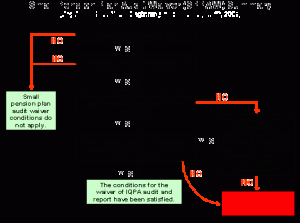Generally, an audit by an independent qualified public accounting firm is required when a plan reaches “large plan” status. Schedule H must be filed with the Form 5500. A plan is considered a “large plan” when there are 100 or more participants at the beginning of the plan year; conversely a “small plan” has less than 100 participants at the beginning of a plan year. Being a “small plan” does not automatically exempt your plan from having to complete an independent audit. See image above to determine whether your “small plan” is exempt from an independent audit.
If a retirement plan has between 80 – 120 participants at the beginning of the plan year, the plan can elect to file the same category (small vs. large) as the previous plan year.
Full or Limited Scope Audit?
DOL Regulation 29 CFR 2520.103-8 determines whether the plan can undergo a limited-scope audit. If a benefit plan has all of its assets held by a bank or insurance company and written certifications are provided by the institutions holding those assets, then Plan Administrator has the option of completing a limited-scope audit. However, all plans that are required to file a Form 11K with the Securities Exchange Commission must have a full-scope audit conducted.
Under a limited-scope audit, the independent accounting firm is not required to perform any auditing procedures relating to the investments. Your auditors will still examine procedures in all other audit areas (e.g., participant data, contributions, distributions, etc.). A limited-scope audit significantly reduces the cost of the audit.
What Areas Are Covered in an Audit?
Auditors will use their judgment to determine the nature and scope of audit tests to be performed, based on their knowledge of the Plan’s control environment, nature of the Plan and other factors. In general, audits of employee benefit plans will address the following areas:
- Contributions to the plans – both employee and employer
- Distributions from the plan
- Participant loans from the plan
- Expenses paid by the plan
- Plan investments and income
- Participant data
- Tax compliance and related party transactions
At the conclusion of the audit, the auditor will issue a report and state an opinion on the plan’s financial statements as well as any schedules required to be included as a part of the plan’s annual report filing. Auditors will also report on significant problems, if any were found. The auditor may also suggest ways to improve internal controls and plan operations.
How Long Does it Take to Complete an Audit?
Although it may be possible to complete a quality audit in less time, it is desirable to begin the audit at least two to three months prior the due date, to allow time to plan the audit, gather information, receive responses to all confirmation requests, perform fieldwork, follow up on open items, draft financial statements and wrap up.
The opinions voiced in this material are for general information only and are not intended to provide specific advice or recommendations for any individual. This information is not intended to be a substitute for specific individualized tax or legal advice. We suggest that you discuss your specific situation with a qualified tax or legal advisor.

